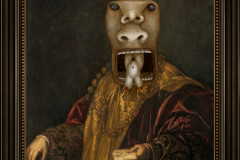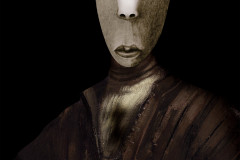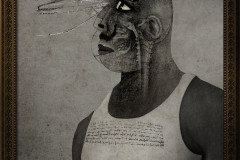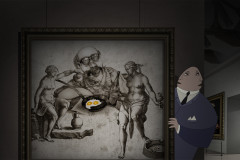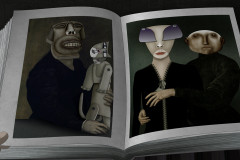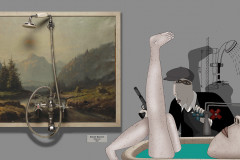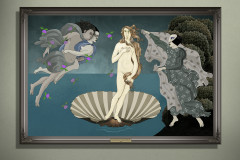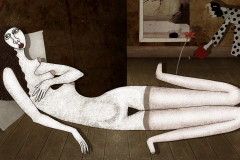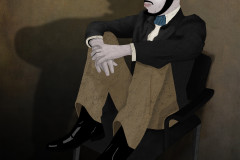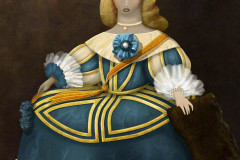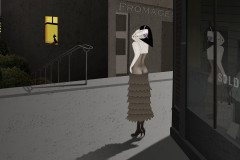Picasso, Pablo (1881-1973): Nő könyvvel, 1932 (olaj, vászon, 130,5 x 98 cm), Pasadena (USA, Kalifornia), Norton Simon Museum. A 20. század egyik legnagyobb művészegyénisége, aki hosszú élete során számos egyéni stíluskorszakot alakított ki, majd hagyott maga mögött, a magánéletben is folyamatosan új, inspiráló kapcsolatokat keresett. 51 éves korában lett szeretője a 17 éves Marie Theresa Walter, akit e festmény a fekete vonalhálót kitöltő élénk színek játékával ábrázol. Picasso egyszerűen nem maradhat ki Ruben Brandt gyűjteményéből.
Nem a Ruben Brandt, a gyűjtő az egyetlen olyan műalkotás, amely más művek iránti tiszteletét és szeretetét úgy fejezi ki, hogy saját stílusában újraalkotja azokat. Picasso Nő könyvvel c. festménye is pont egy ilyen átirat, azaz parafrázis, amelyet az általa nagyra tartott klasszicista festő, Ingres 1856-os Madame Moitessiert ábrázoló portréja inspirált. A fejét tenyerébe hajtva, kényelmesen üldögélő póz felismerhető, de míg Ingres-nél egy legyező van a színes virágos ruhában üldögélő hölgy kezében, Picasso képén a nő ujjai, s a hozzájuk illeszkedő könyvlapok vannak legyezőformába rendezve. Míg a klasszicista kép a polgári illemnek megfelelően csupán bájosan vonzónak ábrázolja a fiatalasszonyt, Picasso félig fedetlen keblű hölgye még „kétdimenzióssága” ellenére is erotikusan hat. A modell háta mögötti falon mindkét képen egy tükör van. Ingres-nél ez a hagyományoknak megfelelően azt a célt szolgálja, hogy a portréalanyt egyszerre láthassuk szemből és profilból is. Picassónál nehezen képzelhető el, hogy a sárga tükörkeretben megjelenő kissé szikár, szigorú profil, aki mintegy felülről „benéz a képbe”, a nőhöz tartozna. Amúgy is inkább férfiarc benyomását kelti - talán maga a festő, aki így egy képen szerepelhet szerelmével... Picasso gyakran élt a klasszikus festészeti alkotások átdolgozásának lehetőségével, élvezettel és hatalmas kreativitással játszott az őt inspiráló művek elemeivel. Érdekes, hogy a Ruben Brandt-ban talán az ő műve az egyetlen, amely változtatás nélkül jelenik meg.
Pablo Picasso (1881–1973): Woman with a Book, 1932
Oil on canvas, 130.5 x 98 cm, Norton Simon Museum, Pasadena (USA, California)
One of the greatest artistic figures of the 20th century, Picasso created and abandoned numerous unique stylistic periods throughout his long life and continuously sought out new, inspiring relationships in his personal life. At the age of 51, he began an affair with the 17-year-old Marie-Thérèse Walter, who is depicted in this painting through a playful interplay of bold colors enclosed by black contour lines. Naturally, a Picasso could not be missing from Ruben Brandt’s collection.
Ruben Brandt, Collector is not the only work of art that expresses admiration and affection for other masterpieces by reinterpreting them in its own style. Picasso’s Woman with a Book is also such a reinterpretation—a paraphrase—inspired by a portrait of Madame Moitessier painted in 1856 by the classicist artist Ingres, whom Picasso greatly admired. The relaxed pose of a woman resting her head in her hand is recognizable, but while Ingres’s lady holds a fan in her hands, here, the woman's fingers and the pages of the book are arranged into a fan-like form.
Whereas the classicist painting, in line with bourgeois decorum, depicts the young lady as merely charming and attractive, Picasso’s half-nude figure appears erotic despite—or perhaps because of—her flat, two-dimensional representation. In both images, a mirror hangs on the wall behind the woman. For Ingres, the mirror serves a traditional purpose: it allows us to see the subject both in profile and head-on. But in Picasso’s version, it is hard to believe that the rigid, rather masculine profile peering into the frame from above, encased in a yellow frame, belongs to the woman. It more likely suggests the artist himself—Picasso—appearing in the same painting as his lover.
Picasso often reworked classic masterpieces, drawing on them with delight and immense creative freedom. Interestingly, in Ruben Brandt, Collector, this may be the only artwork that appears unchanged.


















